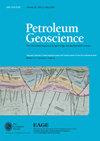澳大利亚苏拉特盆地沉积砂岩和常青层储层模拟概念CO2注入
IF 2.1
4区 地球科学
Q3 GEOSCIENCES, MULTIDISCIPLINARY
引用次数: 10
摘要
下侏罗系沉积砂岩和常青组是澳大利亚苏拉特盆地重要的CO2储层-封存对。然而,很少有地震和井数据来约束最佳概念注入区的储层建模。为了测试可能的储层性能,建立了三个对比扇形规模的静态储层模型,以捕捉相分布和储层性质的地质不确定性范围。这些考虑了苏拉特盆地具有不同古地理排列的部分。模型的重点是捕捉沉淀砂岩(块状砂岩储层:BSR)顶部和常青组(过渡带:TZ)上覆基底部分之间界面的细节,这是了解CO2注入的关键区域。BSR和下TZ采用了对象建模。上TZ和终极密封采用了随机建模,因为这些区域对相分布不太敏感。对孔隙度进行随机建模,并使用孔隙度-渗透率转换函数计算渗透率。动态模拟表明,在适当的CO2注入条件下,TZ有能力阻止CO2流出BSR。这项研究展示了一种在数据稀疏或缺失时捕捉地质非均质性不确定性的方法。向苏拉特盆地注入二氧化碳的有希望的初步建模结果表明,它为气候缓解规模的碳储存提供了一个真正的选择。进一步的调查应侧重于评估与碳储存相关的其他主要风险,如断层密封、反应性流体输送和遗留井的影响。本文是能源地球科学系列的一部分,可在https://www.lyellcollection.org/cc/energy-geoscience-series本文章由计算机程序翻译,如有差异,请以英文原文为准。
Reservoir modelling notional CO2 injection into the Precipice Sandstone and Evergreen Formation in the Surat Basin, Australia
The Lower Jurassic Precipice Sandstone and Evergreen Formation are an important prospective reservoir–seal pair for CO2 storage in the Surat Basin, Australia. However, there is little seismic and well data to constrain reservoir modelling in the best notional injection area. To test the likely storage performance, three contrasting sector-scale static reservoir models were built to capture the range of geological uncertainty in facies distribution and reservoir properties. These considered sectors of the Surat Basin with different palaeogeographical arrangements. The models were focused on capturing detail at the interface between the top of the Precipice Sandstone (Blocky Sandstone Reservoir: BSR) and the overlying basal portions of the Evergreen Formation (Transition Zone: TZ), a critical area for understanding CO2 injection. Object modelling was used for the BSR and lower TZ. Stochastic modelling was implemented for the upper TZ and the Ultimate Seal because these zones were less sensitive to facies distributions. Porosity was modelled stochastically, and permeability calculated using porosity–permeability transformation functions. Dynamic simulation showed the TZ has the capacity to arrest CO2 flow out of the BSR given appropriate CO2 injection conditions. This study shows a method of capturing uncertainty in geological heterogeneity when data are sparse or absent. The promising initial modelling results of CO2 injection into the Surat Basin suggests that it presents a real option for carbon storage at a climate mitigation scale. Further investigation should focus on assessing other major risks associated with carbon storage such as fault seals, reactive fluid transport and the impact of legacy wells. This article is part of the Energy Geoscience Series available at https://www.lyellcollection.org/cc/energy-geoscience-series
求助全文
通过发布文献求助,成功后即可免费获取论文全文。
去求助
来源期刊

Petroleum Geoscience
地学-地球科学综合
CiteScore
4.80
自引率
11.80%
发文量
28
审稿时长
>12 weeks
期刊介绍:
Petroleum Geoscience is the international journal of geoenergy and applied earth science, and is co-owned by the Geological Society of London and the European Association of Geoscientists and Engineers (EAGE).
Petroleum Geoscience transcends disciplinary boundaries and publishes a balanced mix of articles covering exploration, exploitation, appraisal, development and enhancement of sub-surface hydrocarbon resources and carbon repositories. The integration of disciplines in an applied context, whether for fluid production, carbon storage or related geoenergy applications, is a particular strength of the journal. Articles on enhancing exploration efficiency, lowering technological and environmental risk, and improving hydrocarbon recovery communicate the latest developments in sub-surface geoscience to a wide readership.
Petroleum Geoscience provides a multidisciplinary forum for those engaged in the science and technology of the rock-related sub-surface disciplines. The journal reaches some 8000 individual subscribers, and a further 1100 institutional subscriptions provide global access to readers including geologists, geophysicists, petroleum and reservoir engineers, petrophysicists and geochemists in both academia and industry. The journal aims to share knowledge of reservoir geoscience and to reflect the international nature of its development.
 求助内容:
求助内容: 应助结果提醒方式:
应助结果提醒方式:


